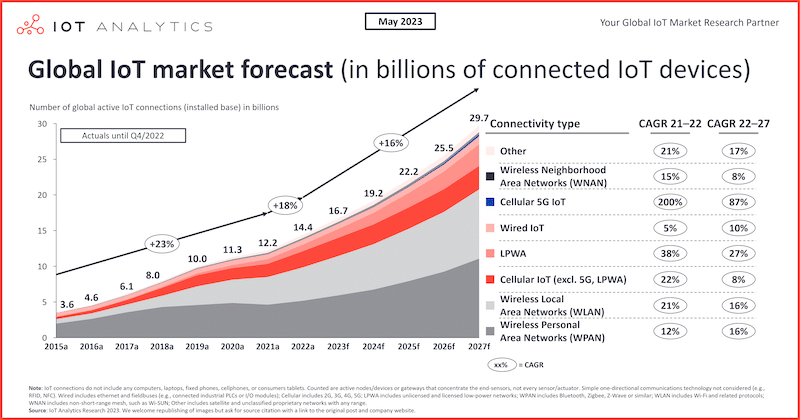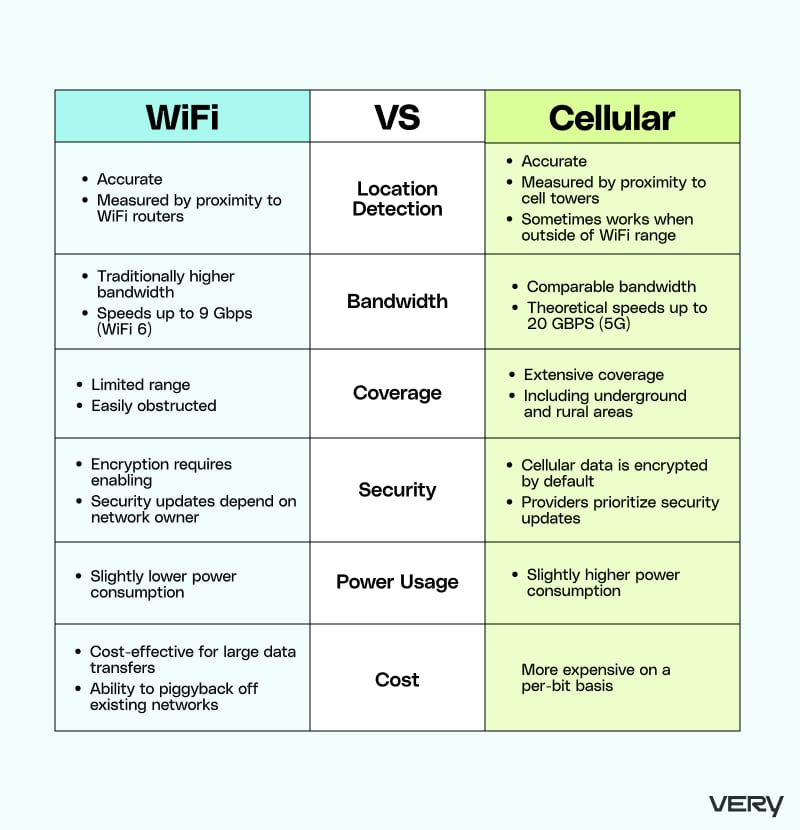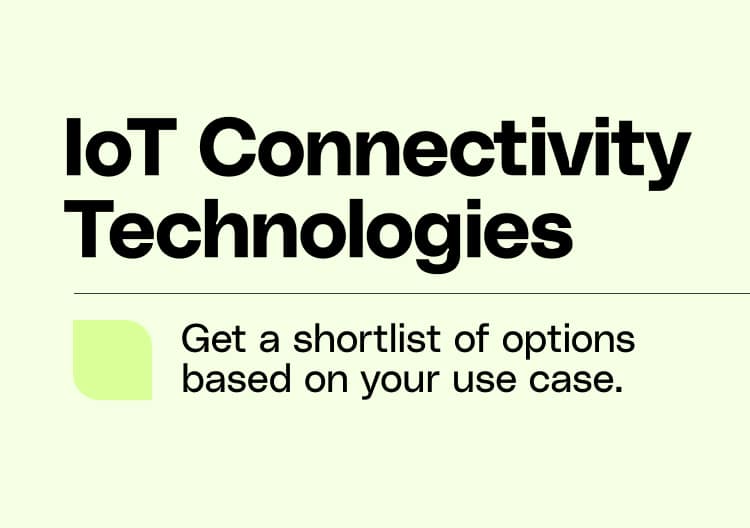BLOG
WiFi vs Cellular: Which is Better for IoT?
As the name implies, IoT (Internet of Things) devices need a stable and secure way of connecting to the Internet to communicate and exchange data. However, the choice of WiFi vs cellular connectivity isn’t always clear-cut.
WiFi and cellular are the two most popular wireless technologies that make IoT networks possible — they provide the “I” in “IoT.” Although WiFi has been the dominant choice in IoT for years, cellular has gained popularity and is now a highly viable alternative.
In this article, we’ll discuss the pros and cons of both WiFi and cellular in IoT networks, helping you decide which to use for your next IoT project.

WiFi for IoT
WiFi technology uses multiple bands of radio waves to transmit information between devices.
In order to have WiFi connectivity, a device must have a wireless adapter that translates data and radio signals. The device communicates with the adapter’s chip using a protocol such as UART or SPI. The adapter then communicates with an external router, which sends this data to the Internet via a wired Ethernet connection.
The three components of this system — device, chip, and router — must conform to the same WiFi standard, such as WiFi 7 or 802.11ax (also known as WiFi 6).
Cellular for IoT
IoT devices that use cellular technology connect to the Internet using the same networks as smartphones and other mobile devices. These devices incorporate a modem to communicate with the nearest cell tower, facilitating the transmission of information. Low-level communication protocols like UART or SPI are employed to control the modem.
LTE-M (Long-Term Evolution for Machines) and NB-IoT (Narrowband IoT) are two popular cellular IoT technologies. LTE-M offers faster speeds and compatibility with existing LTE infrastructure, while NB-IoT requires cellular providers to upgrade their hardware, resulting in a slower rollout. Additionally, NB-IoT provides wider coverage but requires the device to be stationary.
WiFi vs. Cellular: IoT Feature Comparison
This section will dive into how WiFi and cellular stack up in terms of different features for IoT devices.
Cost
Cellular networks tend to be much more expensive than WiFi on a per-bit basis. As a result, WiFi is preferable when you plan to make large data transfers such as security updates on a recurring basis. In addition, you can sometimes “piggyback” off an existing public or private WiFi network to save on costs.
Security and Privacy
Cellular networks enjoy two major security advantages over WiFi:
- Cellular data is encrypted by default, while encryption must be enabled for WiFi connections.
- Cellular security updates are handled by providers with dedicated cybersecurity staff, prioritizing security due to financial and reputational incentives. In contrast, WiFi security relies on individual WiFi network owners to proactively install updates.
While cellular networks are generally held to a higher security standard, well-maintained private WiFi networks can offer comparable security.
Location Detection
Both WiFi and cellular can provide accurate location information by measuring your distance from the nearest routers or cell towers, respectively. In some instances, cellular networks may be able to pin down your location when you’re out of WiFi range.
Coverage
Cellular networks have extensive coverage that continues to expand. Cellular IoT technologies like LTE-M and NB-IoT provide deeper coverage than traditional cellular technologies, reaching places such as underground areas, metal buildings, and rural environments.
WiFi has a limited range and is also more easily obstructed by obstacles. As a local area network (LAN), WiFi can provide strong coverage in a limited area close to an access point. Once the device leaves that area, however, connectivity will decline rapidly. In other words, WiFi isn’t the best choice if the device will be highly mobile or deployed in a remote location.
Bandwidth
WiFi and cellular networks now offer comparable maximum speeds, although achieving those speeds on a cellular network can be more costly.
Traditionally, WiFi outperformed cellular in terms of bandwidth, with speeds up to 450 megabits per second for older WiFi standards (802.11b/g/n) and up to 9 gigabits per second for the newer WiFi 6 (802.11ax) standard.
Cellular technologies based on the 5g standard can theoretically reach speeds as fast as 20 Gbps, making cellular bandwidth comparable with WiFi. With advancements in mobile technology, cellular is sufficient for nearly every IoT use case.
WiFi does have one disadvantage: the more devices trying to access the network, the more the WiFi signal will degrade. This means that WiFi performs noticeably worse in high-population areas as devices compete for bandwidth. Cellular networks typically don’t face this issue, thanks to the technology’s underlying protocols and hardware.
Power Usage
Both cellular and WiFi technologies can significantly consume power if not properly managed to save battery life. Though generally, WiFi will probably use somewhat less. Device manufacturers deal with these issues in two ways: either putting the device to sleep and waking it up at regular intervals, or disabling the connectivity when it’s not in use.

WiFi vs. Cellular: Which Is Better for Your IoT Project?
As we’ve discussed, there are many factors and variables that can make this decision more complicated than it first appears. Both technologies are used to address different kinds of challenges, and neither one is universally superior.
And while WiFi or cellular may be the obvious choice in certain situations, business requirements can complicate matters. For instance, deploying IoT devices in third-party retail stores that may not provide WiFi credentials can impact the decision.
You might even find yourself choosing not which technology to use, but which to use first. Many IoT products use both cellular and WiFi in order to have a backup in place if the primary technology fails.
The choice between WiFi and cellular for your IoT project will depend largely on the priorities of your device and what it will be used for. Ultimately, the decision will come down to making tradeoffs between power consumption, bandwidth, coverage, and security.










